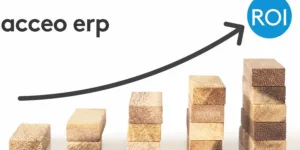ERP software solutions are incredibly common today. Selecting the right package for your business can be daunting, especially when you’re faced with many different options, each of which could be a great fit for your company. This software can be a major advantage for the organization and efficiency of your business, and such an important tool shouldn’t be taken for granted.
Most businesses seek an ERP software solution because they want to better manage their supply chains, customer relationships, and inventory while also offering an excellent ecommerce transaction experience. This will significantly improve your data entering and collections processes and make workflows more efficient.
According to ACCEO ERP, when choosing the right ERP software, it’s best to focus on five categories: productivity, functionality, technology, value, and risk. Each solution you review should promote each of these categories for your team and your business.
While considering these factors, you should also follow the steps mentioned below to properly evaluate your options.
Conduct a Review
As you assess ERP solutions, consider the way each will factor into your day-to-day proceedings, comparing each tool as you go. Look at current processes, strengths, and pain points and how the software will impact each.
One of the best ways to conduct your review is to make a detailed list of your needs and how the ERP system can fill them. “Begin by carefully defining the scope of your project,” Ed Talerico, an ERP solutions manager said to CIO. “Focus on specific business processes and system requirements. The more specific you can be upfront, the more detailed your vendors can be in their proposals.”
Compare Prices
Price should not be the final deciding factor since you might have to pay a little extra for an ERP system that meets your needs. But it should be taken into consideration. As you conduct your review, ask vendors for itemized price quotes. You might find that two systems work very similarly to benefit your business, but one is slightly more affordable.
Evaluate the Cost of Ownership
As you evaluate the price of the software, assess the cost of ownership. When you first talk to an ERP sales rep, they will likely downplay the costs of running your ERP system because they want to make a sale. However, when you install your ERP system, you might find hidden fees and other costs associated with ownership that you didn’t consider in your initial evaluation. Suddenly, it becomes a lot more expensive!
As you gather quotes from vendors, you might unveil hidden costs like implementation, hardware upgrades, software maintenance, and backfilling. If you ask a vendor specifically about these costs, they’ll usually be honest and you can dodge an otherwise nasty bullet.
Ask for References
Websites and vendors are made to sell a product. Therefore, you’ll only see the best things about an ERP solution when going to the source. You will never get a clear picture until you talk to those who have seen the ERP in practice.
“When shopping for an ERP solution provider, ask the vendor for at least three references,” says Reuben Yonatan, founder of GetVoIP.com. “Then, ask the customers what went right, what went wrong and what they might have done differently. If a vendor can’t provide at least three verifiable, happy customers, they may not have the experience you need.”
Develop an Implementation Plan
To sell their products more quickly, vendors will often quote you an implementation duration that might not be accurate. They don’t know your business and its employees, so it would be impossible for them to say exactly how long it will take for your workplace to adjust to the new system.
“Learning a new way of operating will require a significant time commitment for everyone, so the project team must take proactive measures to reduce the burden on employees,” Joel Schneider, co-founder of Liberty Technology Advisor, said to CIO. “Identify department-specific needs, allowing for sufficient time to develop and deliver training programs.”
Evaluate everything from your workflow design to business processes to individual employees. Come up with your own implementation plan and duration to make sure the ERP system will work as seamlessly as possible with your organization.








